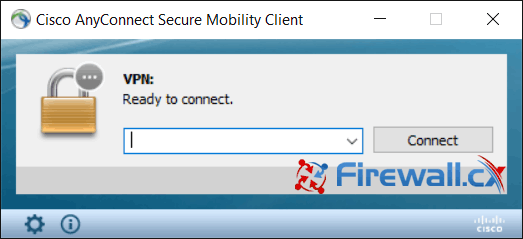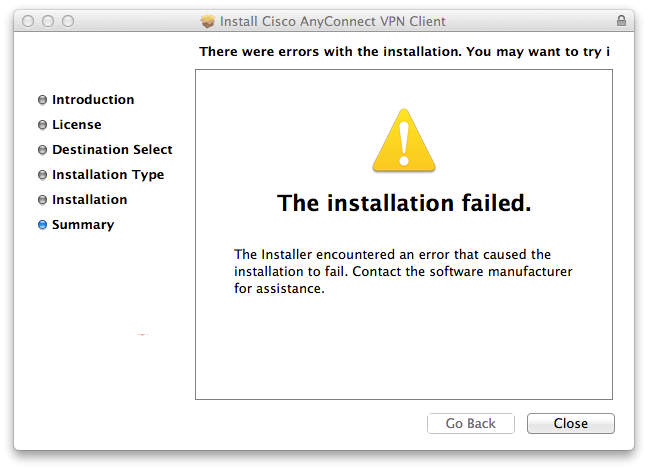- Cisco Anyconnect Vpn Client Installation Problems Today
- Cisco Anyconnect Add Vpn
- Cisco Anyconnect Vpn Client Error
 Skip to end of metadataGo to start of metadata
Skip to end of metadataGo to start of metadataMake sure the Cisco VPN Client you run is at least at 5.0.0.7. Download the PNE software and install it before installing the VPN client. Go to Cisco DNE Support page, and at mid-way through the page under “Other DNE Problems” you will find the download link to 32-bit and 64-bit version of DNE installation file. Download the file. For issues identified by the vendor, see Cisco Systems' Release Notes for Cisco AnyConnect VPN Client. Many times the VPN auto-installer does not succeed in installing VPN software on the first try due to how the installer looks for certificates and when the site is added to your list of trusted sites. Click retry at least once before giving up.
On this page:
Overview

Cisco's AnyConnect VPN is a VPN client that works on a wide variety of operating systems and hardware configurations. The new Cisco AnyConnect VPN client and service will work under Mac OS X (10.6, 10.7, and 10.8), Windows (Vista, Windows 7, and Windows 8, including 64-bit versions), and Linux.
Installation and startup are initiated via a web page that installs and launches a signed ActiveX or Java VPN client to connect to MIT's service quickly and easily. If for some reason neither the ActiveX or Java clients work, you will be given the option to manually download and install the software. For more information, see: Cisco AnyConnect VPN Client at MIT.
Note: You must have an active connection to the Internet before proceeding. Modem users: Make sure you have dialed in to your Internet Service Provider (ISP) before making a VPN connection. Cable or other always-on services should already be connected.
Accessibility Note: Screen reader users must use Internet Explorer to successfully run the web-based VPN service.
Install and Connect via vpn.mit.edu
If you have already connected to the MIT VPN from your machine, you do not have to go to the Website again. The VPN software is installed locally on your workstation. You can launch the MIT VPN from your Applications folder or Start Menu. If you have not previously connected to the MIT VPN on this machine, follow the instructions below.
Click on the thumbnails to view the full size images.
Go to vpn.mit.edu
Result: You are presented with a Login screen.Enter your MIT Kerberos/Athena username and password. Click Login.
Result: You are presented with a Welcome screen.Click Continue
Note: You may be warned about a certificate. Accept or authorize it and continue.
Result: The installer will detect your platform and tries several methods to install the VPN software on your machine.You may be asked to allow the installer access to your computer and enter your computer's administrative password. Do so when prompted. This enables the VPN software to be installed on your computer.
Result: If installation succeeds, proceed to [Step 6]. If the web-based installer failed to find a way to directly install the software, you will be presented with the option to download an installer or retry automatic installation.Automatic installation occasionally fails on the first try. If it does, click Retry.
Note: Many times the VPN auto-installer does not succeed in installing VPN software on the first try due to how the installer looks for certificates and when the site is added to your list of trusted sites. Click retry at least once before giving up and manually installing the software. It frequently works on the second attempt.
If automatic installation fails once more, you will need to install the VPN Client software manually. Download the installer provided (it may be different than the one in the example depending on your operating system).
If the installer does not open automatically, go to your Downloads folder and double click on the installer icon. Follow the prompts to install the software manually.When you see the Connection Established screen, the VPN client software has been installed on your machine and you have been automatically connected to the MIT VPN. You can safely close your browser window.
Connect to MITnet
If you successfully used the web-based AnyConnect page at vpn.mit.edu to install your VPN software, you are connected to the MIT VPN. No configuration is required.
If you previously installed the VPN software and want to launch it to connect to MITnet from your local machine without going through the web interface:


- Windows: Go to Start > Programs > AnyConnect VPN Client > VPN Client.
- Mac OS X: Go to Applications > Cisco > Cisco AnnyConnect Secure Mobility Client.
Result: Cisco AnnyConnect Secure Mobility Client launches. - If the Connect to field is blank, add vpn.mit.edu.
- Click Select
- Enter your username (the first part of your @mit.edu email address, without the @mit.edu), and password.
Result: A message displays 'Welcome to MIT's Virtual Private Network (VPN). - Click Accept.
Result: A message displays Connected to vpn.mit.edu.
